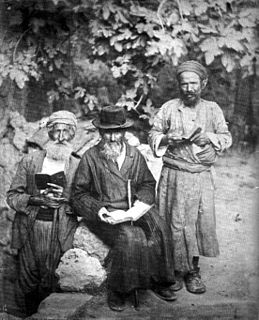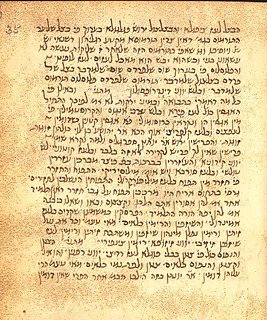Related Research Articles

The Mishnah or the Mishna is the first major written collection of the Jewish oral traditions which is known as the Oral Torah. It is also the first major work of rabbinic literature. The Mishnah was redacted by Judah ha-Nasi probably in Beit Shearim or Sepphoris at the beginning of the 3rd century CE in a time when, according to the Talmud, the persecution of the Jews and the passage of time raised the possibility that the details of the oral traditions of the Pharisees from the Second Temple period would be forgotten. Most of the Mishnah is written in Mishnaic Hebrew, but some parts are in Aramaic.

The Talmud is the central text of Rabbinic Judaism and the primary source of Jewish religious law (halakha) and Jewish theology. Until the advent of modernity, in nearly all Jewish communities, the Talmud was the centerpiece of Jewish cultural life and was foundational to "all Jewish thought and aspirations", serving also as "the guide for the daily life" of Jews.
Asher ben Jehiel was an eminent rabbi and Talmudist best known for his abstract of Talmudic law. He is often referred to as Rabbenu Asher, “our Rabbi Asher” or by the Hebrew acronym for this title, the Rosh. His yahrzeit is on 9 Cheshvan.

Rabbinic literature, in its broadest sense, is the entire spectrum of rabbinic writings throughout Jewish history. However, the term often refers specifically to literature from the Talmudic era, as opposed to medieval and modern rabbinic writing, and thus corresponds with the Hebrew term Sifrut Chazal. This more specific sense of "Rabbinic literature"—referring to the Talmudim, Midrash, and related writings, but hardly ever to later texts—is how the term is generally intended when used in contemporary academic writing. The terms meforshim and parshanim (commentaries/commentators) almost always refer to later, post-Talmudic writers of rabbinic glosses on Biblical and Talmudic texts.

Haim Yosef David Azulai ben Yitzhak Zerachia, commonly known as the Hida, was a Jerusalem born rabbinical scholar, a noted bibliophile, and a pioneer in the publication of Jewish religious writings.
Bezalel ben Abraham Ashkenazi was a rabbi and talmudist who lived in Ottoman Israel during the 16th century. He is best known as the author of Shitah Mekubetzet, a commentary on the Talmud. His most important disciple was the Kabbalist, Rabbi Isaac Luria.

Meir of Rothenburg (c. 1215 – 2 May 1293) was a German Rabbi and poet, as well as a major contributing author of the tosafot on Rashi's commentary on the Talmud. He is also known as Meir ben Baruch, and by the Hebrew language acronym Maharam of Rothenburg. He was referred to by Rabbi Menachem Meiri as the "greatest Jewish leader of Zarfat " alive at the time.
Tamid is the ninth tractate in the Order of Kodashim, which is the fifth of the six orders of the Mishnah, Tosefta and the Talmud. The main subject of Tamid is the morning and evening burnt offerings, but it also deals with other Temple ceremonies. Its full name is "Olat Tamid". The tractate includes information about the Temple Service from sages who had been present at the Temple and witnessed the service. This tractate in the Talmud does not contain disagreements between the sages nor does it have exegetical derivations. It is written as a historical description of the service.
Eliyahu Baal Shem was a Polish rabbi and kabbalist who served as chief rabbi of Chełm. One of the most eminent Talmudists of his generation, he is recorded as the first person known by the epithet "Ba'al Shem" having been considered a great saint and believed to have used miraculous powers to create a golem.

Shevi'it is the fifth tractate of Seder Zeraim of the Mishnah, dealing with the laws of leaving the fields of the Land of Israel to lie fallow every seventh year; the laws concerning which produce may, or may not be eaten during the Sabbatical year; and the cancellation of debts and the rabbinical ordinance established to allow a creditor to reclaim a debt after the Sabbatical year (Prozbul).

Jacob Joshua Falk 1680 – January 16, 1756) was a Polish and German rabbi and Talmudist, known as the Pnei Yehoshua.

Avot de-Rabbi Nathan, usually printed together with the minor tractates of the Talmud, is a Jewish aggadic work probably compiled in the geonic era. Although Avot de-Rabbi Nathan is the first and longest of the "minor tractates", it probably does not belong in that collection chronologically, having more the character of a late midrash. In the form now extant it contains a mixture of Mishnah and Midrash, and may be technically designated as a homiletical exposition of the Mishnaic tractate Pirkei Avot, having for its foundation an older recension (version) of that tractate. It may be considered as a kind of "tosefta" or "gemarah" to the Mishna Avot, which does not possess a traditional gemarah. Avot de-Rabbi Nathan contains many teachings, proverbs, and incidents that are not found anywhere else in the early rabbinical literature. Other rabbinical sayings appear in a more informal style than what is found in Pirkei Avot.

Abraham ben Mordecai Azulai was a Kabbalistic author and commentator born in Fez, Morocco. In 1599 he moved to Ottoman Palestine and settled in Hebron.

Yisroel ben Shmuel Ashkenazi of Shklov was a Lithuanian Jewish Talmudist, one of a group of Talmudical scholars of Shklov who were attracted to Vilna by Rabbi Elijah ben Solomon Zalman, known as the Vilna Gaon (1720–97). He was one of "the last arrivals," and attended upon the Gaon as a disciple for less than a year.

Shabbat is the first tractate of Seder Moed of the Mishnah and of the Talmud. The tractate deals with the laws and practices regarding observing the Jewish Sabbath. The tractate focuses primarily on the categories and types of activities prohibited on the Sabbath according to interpretations of many verses in the Torah, notably Exodus 20:9–10 and Deut. 5:13–14.
Solomon Nissim Algazi was rabbi in Smyrna and in Jerusalem in the 17th century. He was a prolific writer on all topics of rabbinical literature, and won distinction by his treatment of Talmudic hermeneutics and methodology.
Rabbi Joseph Ashkenazi (1525–1572) the Tanna of Safed was a critical commentator on the Mishnah, whose glosses are noted in Solomon Adeni's Mele'khet Shelomo.

Avraham Al-Naddaf (1866–1940), the son of Ḥayim b. Salem Al-Naddaf, was a Yemenite rabbi and scholar who immigrated to Ottoman Palestine in 1891, eventually becoming one of the members of the Yemenite rabbinical court (Beit-Din) established in Jerusalem in 1908, and active in public affairs. His maternal grandfather was Rabbi Yiḥya Badiḥi (1803–1887), the renowned sage and author of the Questions & Responsa, Ḥen Ṭov, and a commentary on the laws of ritual slaughter of livestock, Leḥem Todah, who served as the head of Sanaa's largest seat of learning (yeshiva), held in the synagogue, Bayt Saleḥ, before he was forced to flee from Sana'a in 1846 on account of the tyrant, Abū-Zayid b. Ḥasan al-Miṣrī, who persecuted the Jews under the Imam Al-Mutawakkil Muhammad.
Solomon Sirilio (1485–1554), the son of Joseph Sirilio, was a rabbi and author of one of the first commentaries made on the Jerusalem Talmud.

Isaac ben Melchizedek, , was a rabbinic scholar from Siponto, Italy, and one of the first medieval scholars to have composed a commentary on the Mishnah, of which only his commentary on Seder Zera'im survives. Elements of the Mishnaic order of Taharot are also cited in his name by the Tosafists, but the complete work is no longer extant.
References
- ↑ Encyclopedia Judaica: "Solomon Adeni (1567-1625)"
- ↑ Introduction to the Mishnah Commentary, Melekhet Shlomo.
- ↑ The Jewish Encyclopedia Isidore Singer, Cyrus Adler - 1964 "..and he counted among his pupils such men as Isaac Luria and Solomon Adeni."
- ↑ Abraham Isaac Laredo Les noms des Juifs du Maroc Page 383 - 1978 "Joseph ASHKENAZI, rabbin, commentateur de la Mishnah à Safed, mort entre 1575 et 1582. Quoique venu de Vérone, Joseph appartenait à une famille d'origine allemande. Ses gloses sur la Mishnah ont partiellement été publiées dans le"
- ↑ "Hebron: A Hebron Community - Hebron, City of the Patriarchs - Official web site of the Jewish Community of Hebron". www.hebron.com. Archived from the original on 2016-02-02. Retrieved 2016-01-28.
- ↑ An allusion to a teaching in the Minor Tractates of the Talmud, Tractate Kallah Rabati 10: Baraita # 55: "The writers of scrolls, phylacteries and door-post scripts, they and their merchants, and the merchants of their merchants, do not see any sign of a blessing."
- ↑ Solomon Adeni, Introduction to Mishnah Commentary "Melekhet Shelomo"
Jewish Encyclopedia bibliography
- Azulai, Shem ha-Gedolim, I. letter Shin, No. 57; II. letter Daleth, No. 7;
- Sambary, ed. Neubauer, in Med. Jew. Chron. i. 152;
- Steinschneider, Cat. Bodl. No. 6890;
- idem, Hebr. Bibl. xvii. 54;
- Jew. Quart. Rev. 1898-99, xi. 339;
- Polak, Perush Bertinoro, Amsterdam, 1856;
- Kaufmann, in Monatsschrift, 1898, p. 40.
![]() This article incorporates text from a publication now in the public domain : Singer, Isidore; et al., eds. (1901–1906). "Adeni, Solomon ben Joshua". The Jewish Encyclopedia . New York: Funk & Wagnalls.
This article incorporates text from a publication now in the public domain : Singer, Isidore; et al., eds. (1901–1906). "Adeni, Solomon ben Joshua". The Jewish Encyclopedia . New York: Funk & Wagnalls.